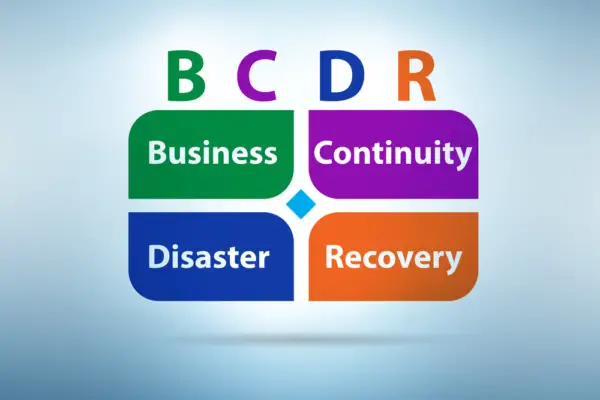Business Continuity Planning (BCP) is important for several key reasons:
- Ensures Critical Operations: BCP allows organizations to maintain or quickly resume mission-critical functions, minimizing the operational impact of a disruption.
- Protects Organizational Reputation: By demonstrating the ability to continue operations under adverse conditions, BCP helps protect an organization’s reputation with customers, partners, and stakeholders.
- Reduces Financial Risk: Effective BCP reduces the potential for financial loss by decreasing downtime and the recovery cost after an incident.
- Compliance and Regulatory Requirements: Many industries have regulations that require a BCP to protect data, continue services, and safeguard customers’ interests.
- Enhances Customer Confidence: Customers are likelier to trust and maintain relationships with companies with proven contingency plans.
- Improves Decision-Making: A BCP during a crisis can lead to more structured and efficient decision-making processes, reducing confusion and error.
- Employee Safety and Well-being: BCP ensures that plans are in place to protect employees during a crisis, a moral and often legal obligation.
- Supply Chain Protection: BCP helps ensure that key suppliers and partners can maintain service delivery, or that alternate arrangements are in place, preserving the integrity of the supply chain.
- Competitive Advantage: Organizations with effective BCPs can recover from disruptions more quickly than those without, potentially gaining a competitive advantage in their market.
- Strategic Value: Developing a BCP can provide strategic insight into organizational processes and dependencies, which can be valuable for long-term planning and growth.
In today’s fast-paced and unpredictable business environment, the need for effective business continuity planning cannot be overstated.

It serves as a crucial framework that enables organizations to navigate through unforeseen disruptions, minimize downtime, and mitigate financial losses.
However, the importance of business continuity planning goes beyond just financial considerations. It also enhances organizational resilience, safeguards reputation and trust, ensures compliance with regulatory requirements, and ultimately contributes to the long-term sustainability of a business.
But how exactly does it achieve all of this? Let’s explore further.
Key Takeaways
- Business continuity planning minimizes operational disruptions, protects financial resources, and ensures swift recovery post-crisis.
- It helps businesses respond effectively to threats, ensures availability of necessary resources, and reduces downtime.
- Business continuity planning safeguards financial resources, implements effective strategies, and protects against significant losses.
- It safeguards reputation and trust, enhances overall success by instilling confidence, and maintains stakeholder relationships.
Minimizing Downtime and Losses
Minimizing downtime and losses is crucial for businesses to maintain their operations and financial stability. By implementing business continuity planning, companies can reduce operational disruptions, protect their financial resources, and ensure a swift recovery in the event of a crisis or disaster.
This proactive approach allows organizations to minimize downtime, mitigate losses, and maintain their competitive edge in the market.
Reduce Operational Disruptions
Efficient management of operational disruptions is crucial for businesses to maintain smooth operations and mitigate potential losses.
To reduce such disruptions, business continuity planning is important. This involves conducting a business impact analysis to identify potential threats and risks to business functions.
By having recovery strategies in place, businesses can minimize downtime and ensure the availability of necessary resources.
This proactive approach helps businesses stay prepared and respond effectively to operational disruptions.
Protect Financial Resources
Protecting financial resources is a critical aspect of business continuity planning. It helps minimize downtime and mitigate potential losses.
By identifying and addressing financial risks, businesses can implement effective strategies to safeguard their resources. This includes developing a recovery time objective to minimize the impact of risks and losses.
Through proactive risk management and robust business continuity efforts, organizations can protect themselves from significant financial losses. They can also ensure the continuity of their operations.
Ensure Swift Recovery
To ensure a swift recovery and minimize downtime and losses, businesses must implement effective business continuity strategies that address potential risks and enable seamless operations.
This can be achieved through the development and implementation of robust and comprehensive business continuity plans.
Key components of such plans include:
- Identifying critical business functions and processes.
- Establishing protocols for responding to incidents and disruptions.
- Ensuring the availability of resources necessary for essential business operations.
Implementing robust and comprehensive business continuity plans is essential for businesses to navigate unforeseen challenges and maintain operational resilience.
Enhancing Organizational Resilience
Enhancing organizational resilience is crucial for businesses to withstand and recover from unexpected disruptions. Building robust systems ensures that critical operations can continue even in the face of challenges.
Crisis response readiness and flexibility in operations further strengthen the organization’s ability to adapt and bounce back, ensuring business continuity and minimizing the impact of disruptions.

Building Robust Systems
To ensure the resilience of systems and operations in the face of potential disruptions, organizations can take several key steps:
- Conduct a business continuity analysis to identify essential functions and critical components of the organization.
- Build robust systems and processes to minimize vulnerabilities and enhance operational recovery.
- Develop an effective response plan to address potential disruptions and mitigate organizational risks.
- Make business continuity planning an ongoing process to adapt to changing circumstances and ensure organizational resilience.
Crisis Response Readiness
Organizations can bolster their resilience by developing a comprehensive crisis response readiness strategy. This involves integrating crisis response readiness into their overall business continuity planning.
A crisis response readiness strategy includes elements such as a disaster recovery plan, risk assessment, and emergency response plan.
It ensures that essential functions and operational processes are identified and protected during disruptive events. Additionally, organizations should establish a crisis management team to effectively navigate and manage crises when they occur.
| Crisis Response Readiness |
|---|
| – Business Continuity Planning |
| – Disaster Recovery Plan |
| – Risk Assessment |
| – Essential Functions |
| – Emergency Response Plan |
| – Crisis Management Team |
| – Operational Processes |
Flexibility in Operations
To enhance organizational resilience, businesses can achieve flexibility in their operations by implementing adaptable strategies and processes.
This flexibility in operations is crucial for maintaining normal operations during times of crisis and disruption.
By incorporating the following strategies into their business continuity planning process, organizations can ensure business resilience and gain a competitive edge:
- Identifying critical functions and essential services.
- Mitigating supply chain disruptions.
- Maximizing employee productivity.
- Implementing comprehensive business continuity planning.
These measures will enable businesses to navigate challenges effectively and continue operating smoothly in the face of unforeseen events.
Safeguarding Reputation and Trust
Safeguarding reputation and trust is crucial for businesses to maintain their competitive edge and secure long-term success.
Reputation protection strategies involve actively monitoring and managing the perception of the organization among stakeholders.
Trust-building measures, such as transparent communication and ethical business practices, are essential for fostering strong relationships with customers, employees, and investors.
Additionally, maintaining stakeholder confidence requires consistently delivering on promises and effectively addressing any issues that may arise.
Reputation Protection Strategies
Implementing effective reputation protection strategies is crucial for businesses to maintain trust and credibility in the eyes of their stakeholders.
To safeguard their reputation and trust, businesses should consider the following strategies:
- Incorporate reputation protection into business continuity planning and disaster recovery planning.
- Conduct regular damage assessments to identify vulnerabilities and risks to reputation.
- Develop crisis communication plans to effectively address reputation-related issues.
- Build organizational resilience by prioritizing reputation protection in essential operations.
Trust-Building Measures
In order to maintain a strong reputation and build trust with stakeholders, businesses must prioritize trust-building measures. Trust-building measures are essential steps in business continuity planning to safeguard company reputation and ensure customer satisfaction.
A well-prepared business continuity plan, developed by senior management, includes measures to protect mission-critical functions and maintain uninterrupted operations. By implementing effective trust-building measures, businesses can instill confidence in stakeholders and enhance their overall success.
Maintaining Stakeholder Confidence
What steps can businesses take to maintain stakeholder confidence and safeguard their reputation and trust?
- Implementing a comprehensive business continuity plan that addresses unexpected events and ensures the organization can continue to operate.
- Prioritizing the key components of stakeholder confidence, such as reputation, customer trust, and financial stability.
- Establishing effective communication channels to keep stakeholders informed during times of crisis.
- Regularly reviewing and updating the business continuity plan to adapt to changing circumstances and ensure its effectiveness in maintaining stakeholder confidence.
Complying With Regulatory Requirements
Complying with regulatory requirements is of utmost importance for businesses as it ensures the fulfillment of legal obligations. By adhering to these regulations, organizations can maintain the trust of their stakeholders and avoid potential legal consequences.
Regulatory compliance encompasses various areas, such as data protection, safety standards, and financial reporting, all of which play a crucial role in safeguarding the integrity and stability of a business.
Regulatory Compliance Importance
Ensuring compliance with regulatory requirements is of utmost importance in business continuity planning. It helps organizations mitigate the impact of a disaster event and minimize potential losses. Regulatory compliance is not only a legal requirement but also a key element of effective business continuity management.
To achieve regulatory compliance, organizations need to develop a detailed plan that addresses all the relevant regulatory requirements. This includes identifying and implementing the necessary measures to meet the standards set forth by regulatory bodies.
Legal Obligations Fulfillment
To ensure business continuity, organizations must fulfill their legal obligations by complying with regulatory requirements. This includes implementing business continuity planning and disaster recovery strategies, which helps businesses prepare for and recover from potential disruptions.
Ensuring Long-Term Sustainability
To ensure long-term sustainability, businesses need to focus on sustainable operations that minimize their impact on the environment and society. This can include adopting renewable energy sources, reducing waste and emissions, and promoting ethical practices throughout the supply chain.
Additionally, businesses should also prioritize building resilience against disruptions, such as natural disasters or economic downturns, by implementing robust business continuity plans that allow them to adapt and recover quickly.
Sustainable Business Operations
In order to maintain long-term sustainability, businesses must prioritize the implementation of sustainable business operations. This involves taking into account potential threats such as natural disasters that could damage the company and its supply chain.
Business owners must ensure that their teams are prepared to respond effectively to such events, ensuring minimal disruption to services. To achieve this, a well-defined response plan should be in place, allowing for prompt action and minimizing any potential damage.
- Prioritize sustainable business operations
- Prepare for natural disasters and threats
- Ensure prompt and effective response
- Minimize damage to company and supply chain.
Resilience Against Disruptions
Businesses can enhance their long-term sustainability by developing resilience against disruptions. Disruptions such as disasters, property damage, and weather-related events can lead to loss of customers and reputational damage. To mitigate such risks, businesses should establish a recovery point objective and ensure that all business units are prepared for unforeseen events.
Additionally, they should implement measures to protect against cyber threats and human error, as these can also cause significant disruptions to operations. By being prepared for unpredictable events, businesses can ensure their long-term survival and success.
Frequently Asked Questions
What Are the Key Steps to Conducting a Business Impact Analysis (Bia) in Order to Minimize Downtime and Losses?
The key steps to conducting a business impact analysis (BIA) involve identifying critical business processes, assessing their vulnerabilities, determining potential impacts of disruptions, and quantifying the financial and operational losses. This analysis helps minimize downtime and losses by informing business continuity planning efforts.
How Can Organizations Develop a Comprehensive Crisis Management Plan to Enhance Their Organizational Resilience?
Organizations can develop a comprehensive crisis management plan to enhance their organizational resilience by conducting a thorough risk assessment, establishing clear communication channels, implementing effective response strategies, and regularly reviewing and updating the plan.
What Strategies Can Be Implemented to Effectively Safeguard an Organization’s Reputation and Trust During a Business Disruption?
To effectively safeguard an organization’s reputation and trust during a business disruption, strategies such as clear communication, proactive crisis management, and transparent actions can be implemented. These strategies help maintain stakeholder confidence and minimize reputational damage.
How Can Businesses Ensure They Are Complying With Regulatory Requirements in Their Business Continuity Planning?
Businesses must ensure compliance with regulatory requirements in their business continuity planning to mitigate risks and protect stakeholders. This involves conducting thorough assessments, identifying critical functions, creating robust response strategies, and regularly testing and updating plans to meet evolving regulations.
What Are Some Best Practices for Ensuring the Long-Term Sustainability of a Business Continuity Program?
Ensuring the long-term sustainability of a business continuity program involves several best practices. These include regularly reviewing and updating the program, conducting comprehensive risk assessments, establishing clear communication channels, and regularly training employees.

Conclusion
In conclusion, business continuity planning is crucial for minimizing downtime and losses, enhancing organizational resilience, safeguarding reputation and trust, complying with regulatory requirements, and ensuring long-term sustainability.
It enables businesses to prepare for and effectively respond to disruptions, ensuring that they can continue to operate and serve their customers.
By implementing comprehensive business continuity strategies, organizations can mitigate risks, maintain stability, and safeguard their long-term success.

Chris Ekai is a Risk Management expert with over 10 years of experience in the field. He has a Master’s(MSc) degree in Risk Management from University of Portsmouth and is a CPA and Finance professional. He currently works as a Content Manager at Risk Publishing, writing about Enterprise Risk Management, Business Continuity Management and Project Management.

